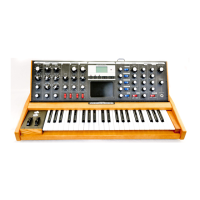30
F. MODULATION BUSSES
Modulation is the heart of making interesting sounds with analog subtractive
synthesis. The Voyager’s two Modulation busses open up a world of modulation
possibilities that were not available on the original Minimoog. The Mod Busses allow
the user to select a variety of modulation sources, their destinations, addition
shaping of the amount of modulation, and a maximum level. The Mod busses are
labeled Mod Wheel and Pedal/On. The performance controls for these two busses
are the Mod Wheel and the MOD1 input on the back panel. The MOD1 input can
accept an expression pedal like the EP-1, and is used like the Mod wheel to fade in
and out the desired modulation. With nothing plugged into the MOD1 input, the
Amount control of the Pedal/On bus determines the strength of modulation.
Here’s a block diagram of a Mod bus (figure 23):

